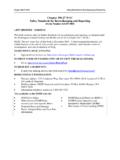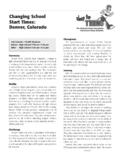Transcription of 2015 NFHS Baseball Rules Book - Stevetheump.com
1 2015 nfhs Baseball Rules book . ROBERT B. GARDNER, Publisher B. Elliot Hopkins, MLD, CAA, Editor nfhs Publications To maintain the sound traditions of this sport, encourage sportsmanship and minimize the inherent risk of injury, the National Federation of State High School Associations writes playing Rules for varsity competition among student-athletes of high school age. High school coaches, officials and administrators who have knowledge and experience regarding this particular sport and age group volunteer their time to serve on the Rules committee. Member associations of the nfhs . independently make decisions regarding compliance with or modification of these playing Rules for the student-athletes in their respective states. nfhs Rules are used by education-based and non-education-based organizations serving children of varying skill levels who are of high school age and younger. In order to make nfhs Rules skill-level and age-level appropriate, the Rules may be modified by any organization that chooses to use them.
2 Except as may be specifically noted in this Rules book , the nfhs makes no recommendation about the nature or extent of the modifications that may be appropriate for children who are younger or less skilled than high school varsity athletes. Every individual using these Rules is responsible for prudent judgment with respect to each contest, athlete and facility, and each athlete is responsible for exercising caution and good sportsmanship. These Rules should be interpreted and applied so as to make reasonable accommodations for athletes, coaches and officials with disabilities. 2014, This Rules book has been copyrighted by the National Federation of State High School Associations with the United States Copyright Office. No one may republish any material contained herein without the prior written consent of the nfhs . Republication of all or any portion of this Rules book on the Internet is expressly prohibited. Published by the NATIONAL FEDERATION OF STATE HIGH SCHOOL.
3 ASSOCIATIONS, PO Box 690, Indianapolis, Indiana 46206; Phone: 317-972-6900, Fax: , Cover photos courtesy of Colorado - Jack Eberhand, TABLE OF CONTENTS. Rule 1. Players, Field and Equipment Rule 2. Playing Terms and Definitions Rule 3. Substituting Coaching Bench and Field Conduct Charged Conferences Rule 4. Starting and Ending Game Rule 5. Dead Ball Suspension of Play Dead Ball Tables Rule 6. Pitching Rule 7. Batting Rule 8. Baserunning Baserunning Awards Table Rule 9. Scoring Record Keeping Rule 10. Umpiring Suggested Speed Up Rules Suggested Double First Base Rules Comments on the Rules Points of Emphasis Rules by State Association Adoption Major Rules Differences Officials' Signal Chart Mission Statement Suggested Guidelines for Management of Concussion in Sports Equipment Guidelines Communicable Disease Procedures Lightning Guidelines Coaches Code of Ethics Officials Code of Ethics nfhs Disclaimers Each state high school association adopting these Rules is the sole and exclusive source of binding Rules interpretations for contests involving its member schools.
4 Any person having questions about the interpretation of nfhs Rules should contact the Rules interpreter designated by his or her state high school association. The nfhs is the sole and exclusive source of model interpretations of nfhs Rules . State Rules interpreters may contact the nfhs for model Rules interpretations. No other model Rules interpretations should be considered. DISCLAIMER nfhs Position Statements and Guidelines The nfhs regularly distributes position statements and guidelines to promote public awareness of certain health and safety-related issues. Such information is neither exhaustive nor necessarily applicable to all circumstances or individuals, and is no substitute for consultation with appropriate health-care professionals. Statutes, codes or environmental conditions may be relevant. nfhs position statements or guidelines should be considered in conjunction with other pertinent materials when taking action or planning care.
5 The nfhs reserves the right to rescind or modify any such document at any time. Position Statements are located at the end of this eBook. Requests for Baseball rule interpretations or explanations should be directed to the state association responsible for the high school Baseball program in your state. The nfhs will assist in answering Rules questions from state associations whenever called upon. New Rules changes are denoted with highlights. 2015 Baseball Rules Changes 1-5-1: Clarified the compliant type of surface for batting helmets and reaffirmed that batting helmets shall meet the NOCSAE standard. 2-16-1f, g: Clarified additional examples of a foul ball. 2-21-4, 5: Clarified the distinction between follow-through interference and backswing interference. 3-3-1f: Deleted the restriction of using video monitoring and replay equipment. 3-3-1 PEN: Deleted the accompanying penalty. 5-1-1n: Clarified that backswing interference is an immediate dead ball.
6 7-3-5c: Clarified the Rules for follow-through interference by the batter. 7-3-7: Clarified the Rules for backswing interference by the batter. 7-3-7 PEN: Added the appropriate penalty for backswing interference. Courtesy Runner: Clarified how a courtesy runner is used in a specific scenario. Points of Emphasis (For a complete discussion of these points of emphasis, see Points of Emphasis Discussion). 1. Helmet maintenance and usage 2. Pitching substitution/change 3. Sportsmanship Celebrations around or near home plate 4. Sportsmanship Post-game ejections Requests for Baseball rule interpretations or explanations should be directed to the state association responsible for the high school Baseball program in your state. The nfhs will assist in answering Rules questions from state associations whenever called upon. Rule 1 Players, Field and Equipment The nfhs does not perform scientific tests on any specific items of equipment to determine if the equipment poses undue risks to student-athletes, coaches, officials or spectators.
7 Such determinations are the responsibility of equipment manufacturers. SECTION 1 POSITIONS OF PLAYERS. ART. 1 .. In high school Baseball , each team is permitted seven turns at bat (see 4-2-2) during which it attempts to score runs by having its batters become base runners who advance to and touch first base, second base, third base and home plate. The team in the field attempts to end each turn at bat of the opponent by causing three of its batters or base runners to be out. Each of the two teams consists of at least nine players throughout the game (See Exception 4-4-1f), one of whom must be designated captain. ART. 2 .. The captain and head coach represent the team in communications with umpires. The captain's and head coach's duties shall include: 1) providing the umpire-in-chief with his team's lineup card which shall include the name, shirt number, position and batting order of each starting player, the name and shirt number of each eligible substitute should also be listed; and 2).
8 Informing all players as to special ground Rules as announced by the umpire-in-chief. Lineups become official after they have been exchanged, verified and then accepted by the umpire during the pregame conference. The umpire shall not accept the lineup card until all substitutes are listed. There is no penalty assessed. Diagram 1: ART. 3 .. A player is designated on the line up card and in the scorebook by name, shirt number, batting order position and fielding position. A customary arrangement of the fielders is shown in Diagram 1. ART. 4 .. At the time of the pitch, all fielders shall be on fair ground except the catcher who shall be in the catcher's box. A fielder is in fair ground when at least one foot is touching fair ground. PENALTY: Illegal pitch. (2-18). ART. 5 .. A player may change to a different fielding position at any time except that a pitcher, after being listed as such on the official lineup card handed the umpire, cannot change until conditions in 3-1-1 and 2 are met.
9 Changes should be reported to the umpire-in-chief and scorekeeper. SECTION 2 THE FIELD. ART. 1 .. A diamond (or infield) shall be a 90-foot square. When measuring the distance to first base and third base, measure from the apex of home plate to the back edge of the base. The outfield is the area between two foul lines formed by extending two sides of the diamond as in Diagram 2. The infield and outfield, including the boundary marks from home plate to first and third and their extended foul lines, are fair ground. All other area is foul ground. ART. 2 .. All lines on the playing field shall be marked with a material which is not injurious to the eyes or skin. All non-permanent lines should be white. Lime or caustic material of any kind is prohibited. ART. 3 .. The on-deck circle should be to the side and away from home plate, 37 feet if space allows. Neither team's players shall warm up in the other team's on-deck circle.
10 The on-deck circle does not have to be occupied, but if a player wishes to warm up, he shall do so only in his team's on-deck circle, provided the on-deck circle is located safely away from home plate. (2-23). ART. 4 .. When the dugout area is temporarily extended, for any reason, it shall be extended toward the outfield on a line parallel to the foul line. The extension of the dugout area shall be equally applied for both teams. ART. 5 .. When constructing a new field for high school play, the distance from home plate to the nearest obstruction on fair ground should be at least 300 feet down the foul lines and at least 350 feet to center field. It is recommended that the line from home plate through the pitcher's plate to second base run east-northeast. This line, using a steel tape or a strong tape or a cord, must measure 127 feet, 3 3/8 inches from the rear tip of home plate to the middle of second base. The catcher's box, home plate, bases, coaches' boxes, batters' boxes, and three-foot running lane shall be as in Diagram 2.







